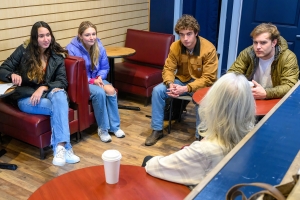
CBL Faculty Collaborative Generates New Community Connections The 2023-2024 academic year at W&L saw the proliferation of several new course offerings for students through a new faculty development initiative offered by the Office of Community-Based Learning (CBL).
“It’s a privilege to work alongside faculty and community partners, finding areas of synergy and building on the knowledge and strength that each brings to the table.”
~ Alessandra Dickovick, associate director of community-based learning
The CBL Faculty Collaborative initiative, launched last year, invites new faculty members interested in engaging in high-impact teaching practices woven into community partnerships. The cohort, led by Sascha Goluboff, professor of cultural anthropology and director of CBL, trains faculty and instructors on the best and most innovative practices in community-based learning, as well as provides them with critical resources and connections across campus to foster professional growth and course development.
Goluboff, who also serves as the interim executive director for the Shepherd Higher Education Consortium on Poverty, was inspired to bring the collaborative to W&L’s campus after working on a similar cross-university project with several other schools with support from a grant from the Associated Colleges of the South. Faculty are not required to teach a CBL course after participating in the collaborative; rather, the group is asked to explore innovative teaching methods and assessment strategies, develop relationships with community organizations and other stakeholders that potentially open doors for future collaborations, and expand their knowledge of the surrounding community.
“The faculty involved in the 2023-2024 collaborative are truly inspirational,” Goluboff said. “We had representation from across the university – business administration (Michelle Cowan and Emily Landry), entrepreneurship and leadership (Jayson Margalus), journalism and mass communications (Toni Locy), earth and environmental geoscience (Karena Gill), Leyburn Library (Amira Walker), and romance languages (Katia Yoza). They developed plans for extremely creative CBL courses (including syllabi, assignments and rubrics), and I was impressed by the decision of many of them to teach those classes this year.”
CBL courses conform to four broad categories, and CBL staff work with W&L faculty members and community partners to decide which model works best for them. Site-based activities place students at designated locations where they serve the mission of a community organization while also developing their knowledge and skills. Project-based activities require students, faculty and community partners to collaborate to address a co-defined goal. In classes focused on research, community partners collaborate with faculty to define the research question, design and implement the project, and shape the final deliverable. Other CBL courses feature community partner seminars where students join faculty and learning partners from the wider community to read, discuss and learn together about a topic of broad social relevance.
Margalus, Johnson Professor of Entrepreneurship and Leadership and the newly appointed director of W&L’s Connolly Center for Entrepreneurship, joined CBL’s faculty cohort this year and moved quickly to incorporate his Design Thinking course into a CBL-designated course that would connect students with the community.
Design thinking is a problem-solving methodology that emphasizes a human-centered, empathy-driven approach to innovation and problem-solving. The Virginia Innovation Accelerator (VIA), located in Buena Vista, is a 25,000-square-foot facility that offers business accelerator services, office and event space and small-scale manufacturing space for growing small businesses. Students spent the first half of the course gaining an understanding of the accelerator’s staff and stakeholders in the community before beginning the design process. The second half of the course then focused on applying their knowledge to solving problems related to interior and exterior design, branding and the organization’s digital and web presence. Each team presented a design brief to VIA, then prototyped potential solutions based on staff feedback.
Nickie Hawkins, VIA’s business outreach and education coordinator, said the partnership has allowed her team to move more quickly on their priorities.
“We have a huge building, a huge number of tasks we’re trying to accomplish and a tiny staff,” Hawkins said, “so for Jay and the Connolly Center to come in with students that can break into teams and start to really address things that would take us months to get to is amazing.”
Hawkins added that students demonstrated throughout the process that they were gaining valuable insights into applying what they were learning in class to the real-world constraints of a small nonprofit organization.
“They were very thoughtful in their recommendations,” Hawkins said.
Art major Jed Heald ’24, who is minoring in entrepreneurship, was on the interior design team and said he enjoyed how immersive the experience was, as well as the ability to continually refine the team’s recommendations toward practical solutions through conversations with VIA.
“It was fun to see the relationship between our team and VIA progress,” Heald said.
Margalus describes his role as a facilitator and said the class relies on the students’ drive and initiative.
“It’s really empowering for the students to be able to take control of their educational experience,” Margalus said, “to get a consulting experience while learning about design thinking, and then to channel all that energy into something where they can affect positive change and see that impact.”
Margalus said that being involved in the CBL faculty collaborative while simultaneously teaching the course has helped him reflect and talk through modifications he’d like to make in the future and to benefit from the continual support of CBL’s established community relationships.
Visiting Assistant Professor of Spanish Katia Yoza partnered with Boxerwood, a local nature preserve and education center, for her Spanish 398 course on indigenous Amazonian and Andean knowledge of the environment. The course, conducted entirely in Spanish, looks at how Amazonian and Andean indigenous communities offer models for reimagining our relationship with nature. As part of their final project, students were asked to create learning modules that could be incorporated into Spanish-language learning programs offered by Boxerwood’s education team, primarily through the site’s partnership with Programa SOL, a three-week summer program for area elementary school students founded by W&L’s English for Speakers of Other Languages student organization.
Elizabeth Gonzalez Avalos ’24 and Spencer Merrill ’24, ESOL’s current co-presidents, were students in Yoza’s class, and said the opportunity to hear from Boxerwood’s education team about how they might adapt the students’ ideas into future educational programming synthesized the concepts they explored in their coursework in a meaningful way.
“What I took away the most was the impact of serving in a role where you’re constantly interacting with the environment, seeing how that can impact your life and impact the lives of others, especially within the context of working with children through programs like Programa SOL,” Merrill said of the collaboration with Boxerwood educators. “Reflecting on the concepts we discussed in class and the work being done at Boxerwood emphasized nature’s ability to teach.”
Elise Sheffield, Boxerwood’s education director, said having the student’s research and perspective adds a welcome layer to Boxerwood’s educational program planning.
“Our mission is to educate and inspire people to be stewards of the Earth,” Sheffield said. “We’re a creative place, so the offering of gaining more insight through students’ research can catalyze more connections in our work with the community.”
Yoza said the course was inspired by her desire to pair her research interests with a community-impact project, and that her participation in CBL’s Faculty Collaborative helped tremendously in shaping its syllabus.
“In conversations with Sascha and the rest of the cohort, we shared ideas about what questions to ask to encourage more reflection by the students on their experience,” Yoza said. “I don’t know that the course would have turned into what it is without those conversations.”
Gill, visiting assistant professor of earth and environmental geoscience, not only brought students in her Dynamic Earth: Introductory Geology course onto hiking trails and into the national forests in the surrounding area for field work, but asked students to incorporate their findings into a final deliverable for the US Forest Service.
“One of the objectives of the course is for students to then be able to give a general overview of the geology of the area,” Gill said, “linking it back to the formation of the Appalachians and bringing the big-picture geology down to smaller scale to apply that to the concepts that they’re learning in class.”
As part of their final deliverable for the course, the students created informational signage that can be used at the kiosk near the base of a hiking trail at Devil’s Marbleyard to inform visitors about the rock formations they will see along their hiking route.
Lauren Stull, district ranger for the Glenwood-Pedlar Ranger District under the USDA Forest Service, said her office welcomed the opportunity to work on a geology-based project with W&L.
“The Marbleyard and James River Face Wilderness is a special place, and this project allows us to share information on the unique geology and natural history of the area with future visitors,” Stull said. “I believe that when people better understand these special places, stewardship is a natural outgrowth of appreciation. Dr. Gill’s students have created the opportunity for visitors to deepen their connection and respect for public lands, and I’m grateful for the care that’s evident in their work.”
Harry Gregory ’27 said the course has given him a deep appreciation for the work of the forest service and the natural landscape surrounding W&L’s campus.
“I have developed a passion for the outdoors,” said Gregory, who is now interested in pursuing more geology courses in addition to his intended economics major.
Gill said in addition to the informational signage, the students went “above and beyond” to create a children’s scavenger hunt game, social media posts, informational videos and even a draft website.
Gill said the seed of the idea for the course was born from learning more about the Office of Community-Based Learning and how she could incorporate a community partnership and impact project into an existing course syllabus. Alessandra Dickovick, associate director of community-based learning, connected her to Stull, having worked with the USDA Forest Service in the past through other CBL projects. Gill said this was instrumental in helping her get quickly connected with one community partner on whom she could focus the class’s energy.
“Having Alessandra’s assistance in crafting guidelines and expectations with the community partner helped me to focus on the project itself,” Gill said. “Then, going through the different components with Sascha as part of the faculty collaborative, where she outlined things like how to create rubrics, how to frame discussions and talked through what I wanted the students to get from the course was also very helpful for defining the scale and deliverables for the class.”
“It’s a privilege to work alongside faculty and community partners, finding areas of synergy and building on the knowledge and strength that each brings to the table,” Dickovick said. “The magic of CBL happens when we shape a collaboration to not only elevate the learning of students in the classroom, but also have a broader impact in the community. It’s a win-win.”
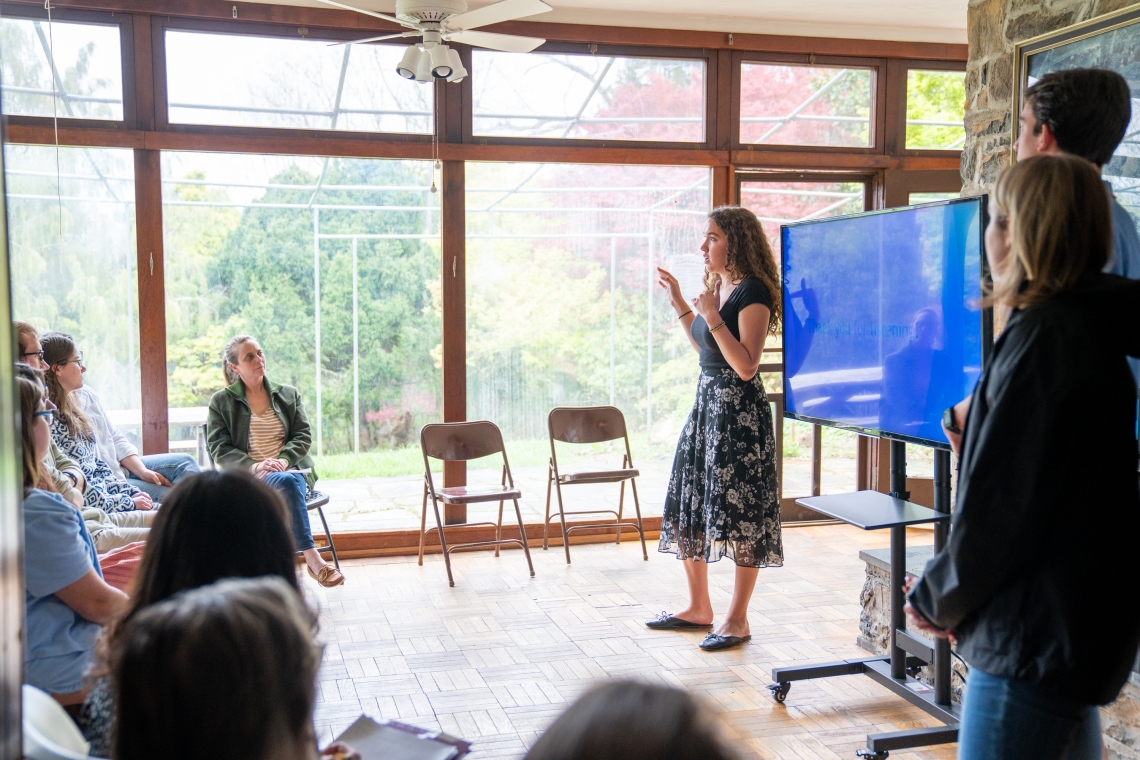 Students in Katia Yoza’s class present their findings to Boxerwood educators.
Students in Katia Yoza’s class present their findings to Boxerwood educators.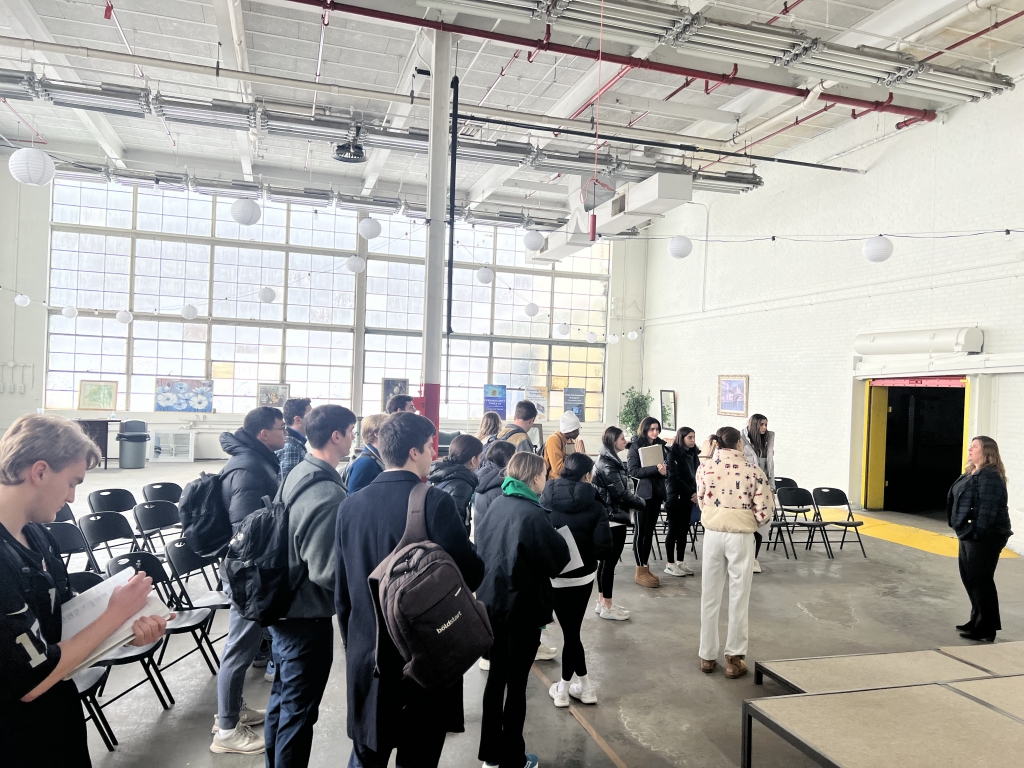 Jay Margalus takes his Design Thinking class for a site visit at the Virginia Innovation Accelerator.
Jay Margalus takes his Design Thinking class for a site visit at the Virginia Innovation Accelerator.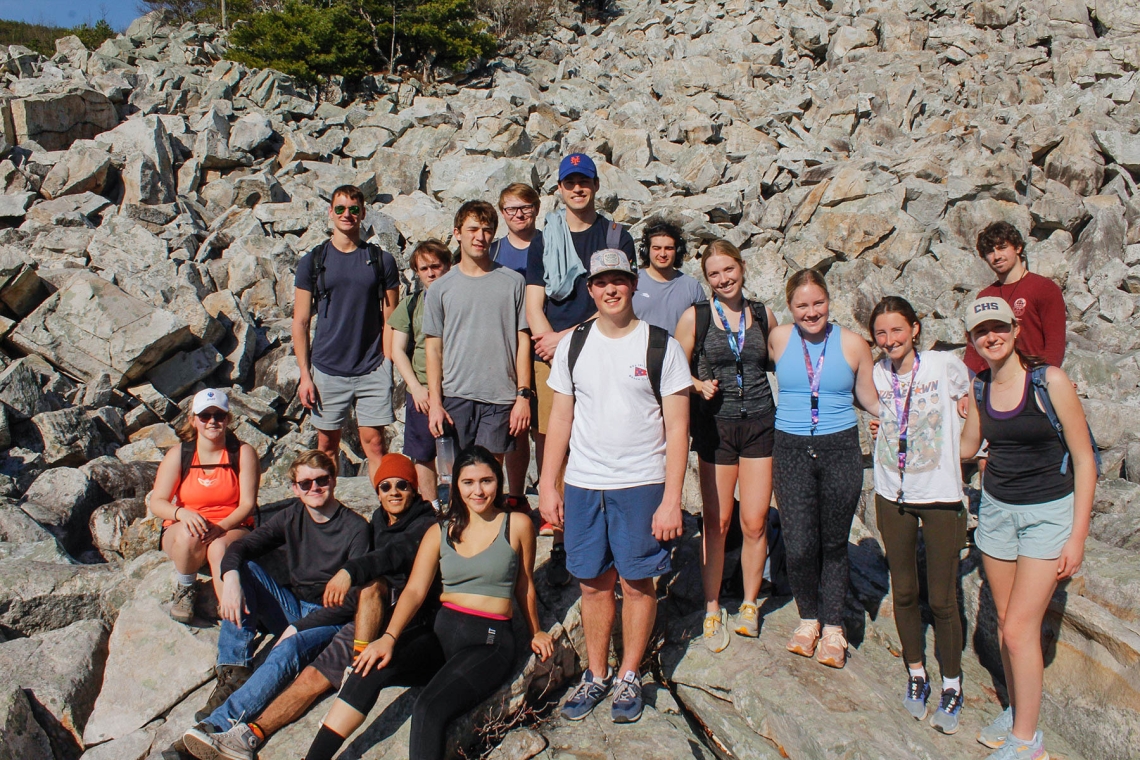 Karena Gill’s geology course visits Devil’s Marbleyard.
Karena Gill’s geology course visits Devil’s Marbleyard.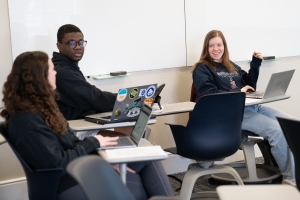

You must be logged in to post a comment.